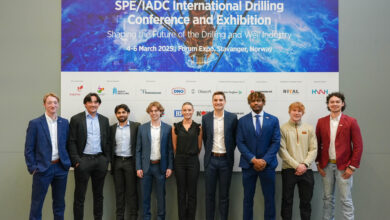Technical Session 12 – Managed Pressure & Underbalanced Drilling
Editor’s note: These abstracts have been edited for space and clarity. This program is current as of 15 January 2013. Additions, withdrawals and other changes to the conference program after this date may not be reflected. Click here for the most updated program.
TECHNICAL SESSION 12: MANAGED PRESSURE AND UNDERBALANCED DRILLING
SPE/IADC 163501
Utilizing Wired Drill Pipe Technology During Managed Pressure Drilling Operations to Maintain Direction Control, Constant Bottomhole Pressures and Wellbore Integrity in a Deep, Ultra-Depleted Reservoir, J.C. Rasmus, Schlumberger
A recently drilled well into an underpressured reservoir provided an opportunity to demonstrate the applicability of wired drill pipe (WDP) to deliver the required measurements and maintain the proper directional control while keeping the well fluids under control. During WDP operations, both the traditional mud pulse transmission and the new WDP transmission methods are available, providing 100% data transmission reliability.
SPE/IADC 163546
Anatomy of MPD Well Failures: An Investigation into the Sensitivities to Success on a Series of Difficult Wells, B. Dow, L.D. Smith, A. Voshall, P.N. Spriggs, Schlumberger
The authors will look at a series of uniquely different wells, all employing MPD but for different technical reasons. Exploration drilling through challenging pore pressure ramps, high angle and horizontal wells across formations highly sensitive to pressure cycling, PMCD wells and wells drilled through very narrow pore pressure and stability window across depleted zones. Analysis of the detailed design during the planning phase, with the information that was known at that time, will lay the foundation of how each well was executed. In each case, the desired outcome was not achieved for reasons unique to the respective project falling outside the core MPD engineering design.
Analysis of the failures will identify key lessons learned and show progressive continuous improvement that has made MPD critical to success on future projects and raised confidence of the users.
SPE/IADC 163494
Successful Application of Concentric Casing Nitrogen Injection to Overcome Drilling Challenges and Deliver a Record Horizontal Well in the Tecominoacan Field, M. Salazar, R. Rodriguez, R. Franco, G. Gamez, PEMEX; J. Flor, C. Gonzalez, J. Rueda, W. Colombine, J. Tilley, Halliburton
The Jujo-Tecominoacan field is part of the Bellota Integral Active in the Pemex South Region. It is located in the state of Tabasco, northwest of the city of Villahermosa. Several drilling challenges exist in this field, including horizontal drilling in dolomites with a high compressive strength, under-pressured reservoir requiring the use of a biphasic drilling fluid with nitrogen injection through concentric casing annular space, crossing through Cenozoic members of abnormally high pressure that require managed-pressure drilling, drilling through inverse geologic faults, and proximity to a salt dome.
The service company and operator formed an interdisciplinary team to meet the challenges of constructing the deepest and longest concentric injection horizontal well, with a total depth of 6,611 meters. A horizontal production section was drilled to a length of 862 meters, with an average inclination of 84°. The main objective was to maximize production in the fractured carbonate formations from the lower Cretaceous to the Kimmeridgian Jurassic formation.
SPE/IADC 163498
The Application of Advanced Gas Extraction and Analysis System Complements Early Kick Detection & Control Capabilities of Managed Pressure Drilling System with Added HSE Value, B. Patel, T.D. Cooper, Weatherford; W. Billings, Talisman Energy
The paper will discuss the successful application of an advanced gas extraction system utilizing an innovative membrane technology and high speed gas chromatograph to improve surface gas detection and analysis capability during MPD operations with a micro-influx control system. Various tests were carried to validate the advanced gas detection system’s capability to detect and analyze gas in mud. During hydrocarbon influx circulation, data from the advanced gas detection system helped to plan the strategy to handle gas on surface. Test data was validated with the results from the real wells.
SPE/IADC 163479
Implementation of PMCD to Explore Carbonate Reservoirs from Semisubmersible Rigs in Malaysia Results in Safe and Economical Drilling Operations, I. Abd Aziz, M. Jayah, Z. Drus, Petronas Carigali; F. Rojas, P. Spriggs, A. Voshall, G. Parayno, Schlumberger
Implementing a variant of the managed pressure drilling called pressurized mud cap drilling (PMCD) has allowed the Petronas Carigali drilling team to reach targeted total depths on several wells.
By successfully implementing the PMCD technique, the operator was able to reduce risk and reach the exploration targets successfully. Lessons learned surrounding operational techniques, pressure limitations of the drilling system and continuous training and development of the operating team have expanded the application for the operator.
The authors present case histories of wells drilled to date and key lessons learned as the operator evolves to improve execution of PMCD.
E-POSTER:
SPE/IADC 163495
Application of UBD and MPD Techniques to Solve Challenges and Optimize Drilling through the Quintuco and Vaca Muerta Formations in the Neuquén Basin, N. Gomez, YPF; O. Montes, R. Leon, J. Benedetti, I. Poletzky, A. Miller, Halliburton
Eleven wells have been drilled in the Neuquén basin, applying UBD and MPD techniques. This paper describes the implementation of these techniques when drilling the 8 ½-in. and 6 1/8-in. sections, along with results, including the evaluation of reservoir potential while drilling, estimation of formation pressures, minimizing formation damage, as lower-density drilling fluids are being used, reduction of NPT, and being able to safely reach the planned TD. Field data is used to illustrate the challenges encountered and results obtained. Lessons learned and how the drilling process has been, and would be, optimized are also discussed.




